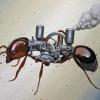- Formiculture.com
- Forums
- Gallery
- Members
- Member Map
- Chat
6 replies to this topic
#1
 Offline
-
Posted August 22 2017 - 12:20 PM
Offline
-
Posted August 22 2017 - 12:20 PM
I'm sitting on my back porch and a ant colony sent out a small initial party of 4 and then a major to do rear patrols and the party just stayed togeather interesting in the fact of they understand strength in numbers and to have a heavier less bulky suport to portect the supply line (yes I'm speaking of it like war tatics bc its alot like tribal setups and that's the only way i can think to compair it) just a note i don't know if any discussion will come out of this but just noticing the simularities and strategies they have realised is quite interesting
- lucas3431 likes this
#2
 Offline
-
Posted August 22 2017 - 8:44 PM
Offline
-
Posted August 22 2017 - 8:44 PM
I've noticed that SOMETIMES nature has always been miles ahead of humanity..
It's quite amazing to say the very least.
It's quite amazing to say the very least.
A question that sometimes drives me hazy: am I or are the others crazy?
#3
 Offline
-
Posted August 22 2017 - 10:48 PM
Offline
-
Posted August 22 2017 - 10:48 PM
Good on you for documenting behavior! It's fun to sit and watch ants as they work. You may find this excerpt from the chapter on foraging behavior in The Ants by Bert Hölldobler and E.O. Wilson helpful in thinking about what you're seeing.
Foraging Strategies
The approximately 8,800 known ant species use a dazzling variety of procedures for the discovery and retrieval of food. Several authors have attempted classifications of this important category of behavior, including Oster and Wilson (1978), Passera (1984), and Moffett (1987b). We will provide a synthesis here of what we regard as the most useful elements of these schemes. The resulting classification breaks all of the phenomena into three categories: hunting (3 kinds), retrieving (4 kinds), and defense (4 kinds). The elements in each can be combined to form 3 × 4 × 4 = 48 possible three-state foraging techniques. This arrangement provides an informal and convenient framework for
the description of the behavior of individual species.
Hunting: (1) by solitary workers; (2) by solitary workers directed to specific trophophoric fields by trunk trails; or (3) by groups of workers searching in concert, in the manner of army ants.
Retrieving: (1) by solitary workers who return home on their own; (2) by individual workers who return home along persistent trunk trails; (3) by individual workers recruited to the food sites by scouts; or (4) by groups of workers who gang-carry the food items.
Defense: (1) by guard workers during hunting or (2) the absence of such defense; (3) by guard workers during harvesting and retrieval of food; or (4) the absence of such defense.
Although no complete accounting has been attempted across all of the ants, it is our impression that virtually all of the 48 possibilities in this broad space of foraging techniques are employed by one species or another. At one extreme are the completely solitary foragers, including scavengers and specialized predators in all subfamilies other than the army ants of the subfamilies Dorylinae and Ecitoninae. The workers hunt singly and retrieve food items entirely on their own. At the other extreme are the army and driver ants of the genera Eciton and Dorylus, who hunt in groups, often gang-retrieve large prey items, and deploy specialized guard workers along the perimeters of the foraging columns.
The total foraging strategy of an ant species often comprises two or more three-state techniques, each chosen according to the quality and nature of the food of the moment. For example, when the solitary foragers of Pogonomyrmex encounter a seed or dead insect small enough to be carried singly, they carry it home alone. When the object is too large to be transported by one ant, or there is a cluster of small food items, the worker lays a recruitment trail with secretions from her poison gland. When the food is persistent at a particular site, as is the case for a continuing seedfall, the ants deposit trunk trails with secretions that come at least in part from the Dufour’s gland (Hölldobler and Wilson, 1970; Hölldobler, 1971b; Hölldobler, 1976a). The minor workers of the Amazonian myrmicine Pheidole embolopyx also search in solitary fashion and single-load the small insects they encounter. When the food item is too large to move, the scouts recruit other minor and major workers from the nest. The majors spend most of their time carving up the insect and defending it from intruders, while the minors concentrate on drinking the hemolymph and carrying fragments back to the nest (Wilson and Hölldobler, 1985). Minor workers of very small Pheidole dentata colonies spend more time feeding away from the nest and transferring the food to nestmates within the nest, as well as less time recruiting, than do minor workers in larger colonies. Evidently the effort of a single worker can more nearly satisfy the requirements of the small colony (Burkhardt, 1983).
Recruitment thus permits a multiple strategy of foraging and permits the exploitation of a wider range of food items. When workers of Monomorium, Myrmica, Formica, and Lasius forage singly, prey size is positively correlated with worker size. Yet when cooperative foraging based on recruitment is used, the correspondence breaks down. The ants are able to handle items far larger than their individual size (Traniello, 1987a). Although the workers in Traniello’s study varied in fresh weight from 0.1 to 6.8 milligrams, their arthropod prey varied from 1 milligram to over 2 grams, a 2,000-fold range from the lightest to the heaviest.
- Shaye, Martialis and T.C. like this
#4
 Offline
-
Posted August 23 2017 - 12:39 AM
Offline
-
Posted August 23 2017 - 12:39 AM
What I find interesting when looking at my Camponotus is that they do not seem to have a clear pathway to the food (which always is in the same place).
There are two pathways that are used most frequently (one along the edges of the glass tank and another one through an open area in front of the nest) but a lot of ants sort of stray from this path and use a diagonal shortcut and the way they move around obstacles is also pretty random.
- Martialis likes this
We should respect all forms of consciousness. The body is just a vessel, a mere hull.
Welcome to Lazy Tube - My Camponotus Journal
#5
 Offline
-
Posted August 24 2017 - 2:57 AM
Offline
-
Posted August 24 2017 - 2:57 AM
Seems like some like thrfirst rock they case the area on the way to the food in your photo like a bank robber... clear all paths something can sneak up or that could be used to hide and try to grab em and others like the branches seem like a way to minimize trafic
#6
 Offline
-
Posted December 27 2017 - 3:17 PM
Offline
-
Posted December 27 2017 - 3:17 PM
many war strategies have been taken from ants.
my colony does not follow a path. they cover the whole out world when I give then food. a few 10 or 15 ants work on the food. while 30+ other ants walk around the whole out world. also the only 3 super majors never touch the food. they only stay around it. with their jaws open. while the little ones struggle to get the food inside the nest. 1 or 2 super major could take the food inside in seconds, but they are not that bright. cool to watch. then struggle lol.
my colony does not follow a path. they cover the whole out world when I give then food. a few 10 or 15 ants work on the food. while 30+ other ants walk around the whole out world. also the only 3 super majors never touch the food. they only stay around it. with their jaws open. while the little ones struggle to get the food inside the nest. 1 or 2 super major could take the food inside in seconds, but they are not that bright. cool to watch. then struggle lol.
#7
 Offline
-
Posted December 27 2017 - 3:32 PM
Offline
-
Posted December 27 2017 - 3:32 PM
What I find interesting when looking at my Camponotus is that they do not seem to have a clear pathway to the food (which always is in the same place).
There are two pathways that are used most frequently (one along the edges of the glass tank and another one through an open area in front of the nest) but a lot of ants sort of stray from this path and use a diagonal shortcut and the way they move around obstacles is also pretty random.
I think large established colonies are capable of creating very wide pheromones trails.
Also tagged with one or more of these keywords: ant, path
 |
Ant Keeping →
General Ant Keeping →
How to Professionally Heat my Ants?Started by Entomologyants , Mar 25 2025 |
|

|
|
Ant Keeping →
General Ant Keeping →
What just happened here? Tetramorium immigransStarted by Stubyvast , Feb 16 2025 |
|

|
||
Ant Keeping →
Ant Keeping Journals →
bmb1bee's Cryptic Colonies (updated 17 Feb. 2025)Started by bmb1bee , Dec 2 2024 |
|

|
||
Anting →
Ant ID Requests →
ID wantedStarted by cooIboyJ , Oct 1 2024 |
|

|
||
Ant Keeping →
General Ant Keeping →
Beginner Ant keeperStarted by Camponauto_desperado , Sep 13 2024 |
|

|
1 user(s) are reading this topic
0 members, 1 guests, 0 anonymous users



















